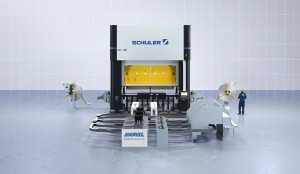The Fraunhofer Institute for Laser Technology ILT hosted the first virtual LKH2 Laser Colloquium Hydrogen in September 2020. The focus was on fuel cells and the question of whether it will be possible to reliably produce bipolar plates every second in the future.
The Fraunhofer-Gesellschaft is consistently focusing on hydrogen, which many see as the coal of the future, and has pooled the strengths of 28 institutes in the "Hydrogen Network", in which the Fraunhofer ILT also participates. During the colloquium, ten presentations covered many aspects of fuel cell production with a strong focus on laser material processing.
The decisive factor for the wider use of fuel cells will be to significantly reduce the costs of membrane electrode assemblies (MEA) and bipolar plates (BPP). The membrane electrode assembly (62%) with its high proportion of platinum and the BPP (30%) currently account for most of the costs of a fuel cell.
To manufacture the bipolar plates, plate halves are welded together and stacked in a stack composite, which not only conducts heat and electricity well, but also provides very reliable protection against the escape of water, oxygen and, above all, hydrogen. Not only does the entire outer contour have to be welded, but also the inlet openings, the so-called ports, for water, oxygen and hydrogen. This results in a total of around 1.0 to 1.4 meters of weld seam per plate. The following is a brief presentation of contributions to the colloquium focusing on laser material processing.
Laser beam microwelding: Reliable and dynamic joining of metallic bipolar plates, André Häusler, Fraunhofer ILT, Aachen (D)
When laser welding BPP in a continuous roll-to-roll process, defects can occur even at low feed rates, jeopardizing the tightness of the seam (humping effect). By switching from the near infrared range (wavelength: 1070 nm) to visible blue or green laser light (450 or 515 nm), the degree of absorption of a typical steel (DC04) can be doubled to almost 50 percent. A 1 kW TruDisk 1020 trunk welded best with green laser light. Further investigations are currently being carried out into how melt pool flow and keyhole dynamics can be influenced by changing the wavelength and beam source so that no humping occurs even at high feed rates.
Laser transmission welding of thermoplastics for plastic-based fuel cells, Maximilian Brosda, Fraunhofer ILT, Aachen (D) / Matthias Poggel, Leister Technologies Deutschland GmbH, Hagen (D)
Plastic components for fuel cells are often blackened with carbon black before laser joining, as they are often transparent components with low absorption. As an alternative, the speaker presented the two-stage INNOCABS process. In this process, the plastic also contains the transparent additive INCA XX21, which turns black when hit by the pulsed laser beam. These locally colored areas have a high degree of absorption, which a CW laser uses for welding in the second step.
The laser as a flexible tool for the economical production of microstructure plates, Fabian Kapp, Graebener Maschinentechnik GmbH & Co. KG, Netphen-Werthenbach (D)
 Focus on large series: The scalable Schuler systems are designed for the production of up to 50,000 stacks with around 15 million bipolar platesThemachine manufacturer develops complete, scalable systems that can produce several million plates per year One particular specialty is hydroforming, which has also proven its worth with 50 µm thin plate foils. The company prefers to cut thin foils using lasers, which, compared to punching, enable high-precision, spatter-free and burr-free cutting of 2D and 3D contours at a maximum feed rate of 2,000 mm/s. If very high quality with burr-free trimming with an absolutely clean cutting edge is required, the company uses laser fusion welding under cutting gas. To join the extremely thin 50 µm foils, Graebener relies on a CW laser, which welds continuously, reliably and gas-tightly and requires no further processing steps.
Focus on large series: The scalable Schuler systems are designed for the production of up to 50,000 stacks with around 15 million bipolar platesThemachine manufacturer develops complete, scalable systems that can produce several million plates per year One particular specialty is hydroforming, which has also proven its worth with 50 µm thin plate foils. The company prefers to cut thin foils using lasers, which, compared to punching, enable high-precision, spatter-free and burr-free cutting of 2D and 3D contours at a maximum feed rate of 2,000 mm/s. If very high quality with burr-free trimming with an absolutely clean cutting edge is required, the company uses laser fusion welding under cutting gas. To join the extremely thin 50 µm foils, Graebener relies on a CW laser, which welds continuously, reliably and gas-tightly and requires no further processing steps.
Large-scale production of metallic bipolar plates for fuel cells, Dr. Hermann Uchtmann, Schuler Group, Göppingen (D) and Mathias Binder, Andritz Soutec AG
As uncoated or pre-coated stainless steel coils (1.4404) have been very expensive up to now, the use of transfer presses should reduce costs by at least 10% compared to progressive presses. Schuler therefore opted for transfer technology for the large-scale production of BPP, for which the company supplies the forming technology and automation.
Laser welding from Andritz Soutec AG in Neftenbach (Switzerland) plays an important role in large-scale production: a scalable system is currently being built for the production of bipolar plates for 50,000 fuel cell stacks per year; this corresponds to the welding of 50 BPP per minute. Three laser welding stations, each with two scanner optics, produce weld seams up to 3.0 m long at a speed of 500 mm/s.
Conclusion:
The diversity of the presentations and the lively discussions showed that there is still a lot of pioneering work to be done in this field. The establishment of a virtual platform is planned to promote the exchange of know-how. Interested parties also received input at the Fraunhofer ILT's third Laser Symposium on Electromobility (LSE) on January 19 and 20, 2021, which took place for the first time as a digital event including a live lab tour.
Source: Fraunhofer ILT


